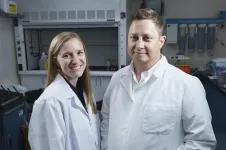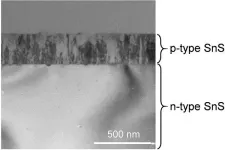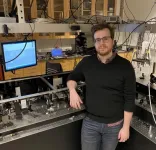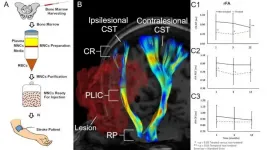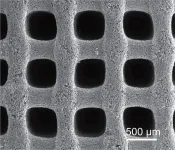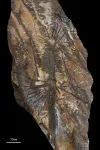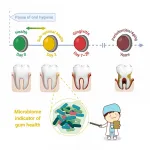A safer MRI contrast agent for high-resolution 3D microvascular imaging
The new contrast agent offers a vast improvement over traditional gadolinium-based products
2021-03-10
(Press-News.org) Heart attack and stroke are the first and second leading causes of death in developed countries, respectively. As the disease often results in sudden death with few special prognostic symptoms, early diagnosis is very important. For this purpose, imaging techniques such as magnetic resonance imaging (MRI) are widely used to identify the narrowing or blockage of blood vessels.
In MRI, contrast agents improve the visibility of the structures such as smaller blood vessels within the body. Just as satellites or global positioning systems (GPS) give traffic congestion information, the MRI contrast agents can give accurate information of vascular conditions such as vascular blockage and stenosis. Commonly used products are the gadolinium-based contrast agents. Free gadolinium ions have high toxicity, and thus they must be administered in chelated forms. However, even then there are some health risks of nephrogenic systemic fibrosis for patients with poor kidney functions. There have been some attempts to use paramagnetic iron-based nanoparticles as contrasting agents, but their renal clearance profile must be improved to prevent undesirable accumulation in the liver and other organs.
A collaborative research team led by Professor CHEON Jinwoo, the director of the Center for Nanomedicine (CNM), Institute for Basic Science (IBS) at Yonsei University, Seoul, South Korea and Professor CHOI Byoung Wook from Yonsei University College of Medicine developed a high-performance MRI contrast agent for 3D vascular mapping. The researchers developed a nanoparticle-based MRI contrast agent, called SAIO (Supramolecular Amorphous-like Iron Oxide). The particle is 5 nanometers in size, which is about 1,500 times smaller than the microvascular diameter. This allows it to circulate across blood vessels in the body.
The SAIO is a special nanoparticle that consist of a polysaccharide core made primarily with dextran cross-linked with other molecules. This core is then coated with an iron oxide surface to give it paramagnetic properties at room temperature. The hybrid nature of the SAIOs gives them both excellent biocompatibility and imaging performance. The researchers compared the contrast performance, retention, and renal clearance profile of the SAIO against Dotarem (a gadolinium-based agent) and iron oxide nanoparticles.
SAIO is one of the highest resolution imaging agents, which is 10 times more precise than the image generated using current contrast agents. It has achieved a 3D brain vascular mapping that can clearly identify brain microvessels as thin as a hair (100 microns) in animal experiments. In addition, to excellent resolution, the enhancement lasts substantially longer (>10 min) in comparison to Dotarem (< 2 min), which gives the radiologist an ample amount of time to carry out the imaging procedures. These excellent properties of the SAIO allowed the researchers to observe the heart blood vessels, which are hardly visible with current MRI contrast agents.
In addition to having high resolution, excretion of the contrasting agent through urine is especially important to avoid its accumulation within the body, which can cause various side effects. SAIO has an excellent renal clearance profile without accumulation in liver or spleen. It was also found that SAIO was stable without aggregation nor iron leaching for up to a year.
Director Cheon said, "SAIO is a next-generation contrast agent that satisfies both high resolution and safety at the same time" and professor Choi said, "SAIO is expected to play a vital role in increasing the accuracy of the diagnosis of cerebro-cardiovascular diseases such as stroke, myocardial infarction, angina, and dementia."
INFORMATION:
The results of this study are supported by the Korea Healthcare Technology R&D Project, Ministry for Health & Welfare and Institute for Basic Science, Republic of Korea. The study was published on March 8th, 2021 in the journal Nature Biomedical Engineering.
[Attachments] See images for this press release:
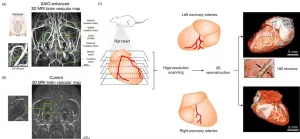
ELSE PRESS RELEASES FROM THIS DATE:
2021-03-10
A year ago, infectious disease doctor Christine Johnston was leading a study on the use of hydroxychloroquine for the treatment of people with COVID-19.
The trial launched at the end of March, when the disease was putting the world on pause and killing thousands.
Hydroxychloroquine showed promise in studies done in test tubes rather than in animals or humans. If the drug worked, it would be cheap, safe, and available. As the trial got going in April, however, hydroxychloroquine was being touted as a treatment without any rigorous evidence.
"The world was at a desperate moment and people were jumping to conclusions," ...
2021-03-10
During the height of the first COVID-19 lockdown in the UK, women spent more time on unpaid housework and childcare than men, were more likely to reduce working hours, and reported higher levels of psychological distress, according to a new study published last week in the open-access journal PLOS ONE by Baowen Xue and Anne McMunn of University College London, UK.
Before the COVID-19 pandemic, studies had already shown that women in the UK today spend more time doing unpaid care work than men. In March 2020, childcare facilities and schools in the UK were shut down in response ...
2021-03-10
Young people at ultra-high risk of developing psychosis have significantly higher psychotic symptoms if they are an evening person, researchers at Orygen, Australia's centre of excellence in youth mental health, have found.
Their research, published last month in the journal Early Intervention in Psychiatry, investigated the link between sleep disturbance, chronotype - whether the young person was a morning or evening person - and psychotic symptoms.
Orygen's Dr Jessica Hartmann, who led the study, said the research involved clinical interviews and self-report ...
2021-03-10
Psychedelic healing may sound like a fad from the Woodstock era, but it's a field of study that's gaining traction in the medical community as an effective treatment option for a growing number of mental health conditions.
While the study of psychedelics as medicine is inching toward the mainstream, it still remains somewhat controversial. Psychedelics have struggled to shake a "counterculture" perception that was born in the 1960s, a view that had stymied scientific study of them for more than 50 years.
But that perception is slowly changing.
Mounting research suggests ...
2021-03-10
A team of researchers from Tohoku University have created a tin monosulfide (SnS) solar cell that boasts attractive performance levels, promoting affordable and clean energy and moving society closer to achieving the UN's sustainable development goals.
Their results were published in the journal Solar RRL on February 25, 2021.
Current thin film solar cells often use cadmium telluride and copper indium gallium selenide to induce the photovoltaic effect. However, these materials contain rare and toxic elements. In contrast, tin and sulfur are abundant, easy to refine and non-toxic.
The key to high efficiency SnS solar cells lies within the p-n homojunction. P-type SnS is easy to fabricate, but the same cannot be said of n-type SnS. The complexity of ...
2021-03-10
Photosynthetic organisms harvest light from the sun to produce the energy they need to survive. A new paper published by University of Chicago researchers reveals their secret: exploiting quantum mechanics.
"Before this study, the scientific community saw quantum signatures generated in biological systems and asked the question, were these results just a consequence of biology being built from molecules, or did they have a purpose?" said Greg Engel, Professor of Chemistry and senior author on the study. "This is the first time we are seeing biology actively exploiting quantum effects."
The scientists studied a type of microorganism called green sulfur bacteria. These bacteria need light to survive, but even small amounts of oxygen can damage their delicate photosynthetic equipment. ...
2021-03-10
Durham, NC - Results of a clinical trial released in STEM CELLS Translational Medicine provide evidence that treating patients with an injection of bone marrow cells may lead to a reduction in brain injury after a stroke.
The study was conducted by Muhammad E. Haque, Ph.D., Sean I. Savitz, M.D., and colleagues from the Institute for Stroke and Cerebrovascular Disease at The University of Texas Health Science Center in Houston. "Nearly 90 percent of patients who suffer an ischemic stroke - the most common type of stroke - exhibit weakness or paralysis to one side of the body," Dr. Haque said. "Injuries to the corticospinal tract (CST), which is ...
2021-03-10
NASA's Perseverance Rover recently made a successful landing on Mars, embarking on a two-year mission to seek signs of ancient life and collect samples. Because Mars is extremely cold -- nighttime temperatures can drop below -112 F -- heaters are required to keep the rover's battery system from freezing. Now, researchers reporting in ACS' Nano Letters have 3D printed porous carbon aerogels for electrodes in ultralow-temperature supercapacitors, reducing heating needs for future space and polar missions.
Jennifer Lu, Yat Li and colleagues wanted to develop an energy storage system that could operate at very low temperatures without heating units, which add weight and energy requirements ...
2021-03-10
A recent study on spectacular fossil plants preserved in a volcanic ash fall deposit--known as China's "vegetational Pompeii," in Inner Mongolia, China--has resolved a mystery that puzzled palaeontology for over a century: What are Noeggerathiales?
The study, published in PNAS on March 8, was led by Prof. WANG Jun from the Nanjing Institute of Geology and Palaeontology of the Chinese Academy of Sciences (NIGPAS) and by Prof. David Dilcher from Indiana University (USA). Researchers from the UK, Czech Republic and Austria were also involved.
The researchers confirmed that Noeggerathiales had the spore propagation mode of ferns and the vascular tissue of seed plants. They belonged to a sister group of seed plants, the former gymnosperm.
Noeggerathiales ...
2021-03-10
Poor oral hygiene produces gum-disease bacteria and accelerates oral microbiome aging faster than previously thought.
A new study shows that within 24-72 hours of the interruption of oral hygiene, there was a steep decrease in the presence of 'good oral bacteria' and the beneficial anti-inflammatory chemicals they are associated with. An increase of 'bad bacteria' typically present in the mouths of patients with periodontitis, a severe gum disease which can lead to tooth damage or loss, was also discovered.
The research team, led by scientists from Single-Cell Center, Qingdao Institute of BioEnergy and Bioprocess Technology (QIBEBT) of the Chinese Academy of Sciences (CAS) and Procter & Gamble Company (P&G), published their findings in the journal mBio on Mar. 9, 2021.
The ...
LAST 30 PRESS RELEASES:
[Press-News.org] A safer MRI contrast agent for high-resolution 3D microvascular imaging
The new contrast agent offers a vast improvement over traditional gadolinium-based products


